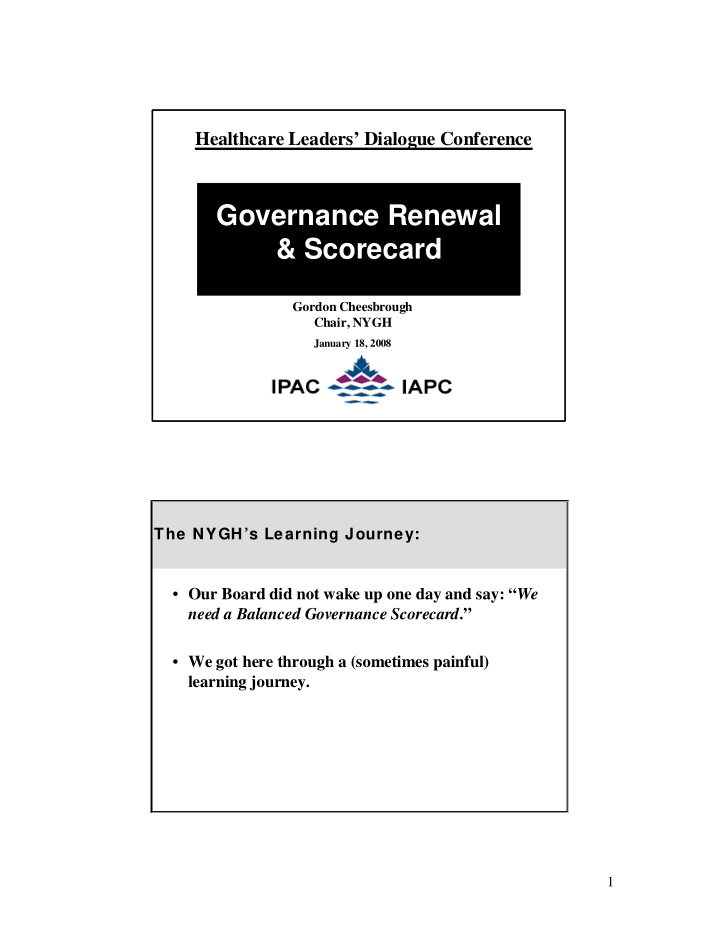



Healthcare Leaders’ Dialogue Conference Governance Renewal & Scorecard Gordon Cheesbrough Chair, NYGH January 18, 2008 The NYGH’s Learning Journey: • Our Board did not wake up one day and say: “ We need a Balanced Governance Scorecard .” • We got here through a (sometimes painful) learning journey. 1
Financial Implosion: $23 Million Deficit Culture/ Leadership Implosion: Epicenter of SARS I & II 2
Governance Realities: • Board uncertain as to our “value-added” role. • Healthcare/ hospitals are complex, non-rational. • How can community Boards “add value”? • What is our role? Provincial Re-Design: • Bill 8 and Bill 36 have created a very different system in the Province of Ontario. • LHIN’s allocate resources. • A new Service Accountability Agreement between the LHIN and our board. • Hold CEO & MAC Chair (or COS) accountable for outcomes. 3
Board Responsibilities Ensure Benefit To Accountable Hold the CEO “Owners” to the LHIN For Accountable For Outcomes “Ends Policies” Provide Board Ensure Quality- Stewardship Responsibilities of-Care and For Mission/ Caring Vision/Values Monitor Executive Ensure Performance with Financial Health BSC A Balcony Perspective “Because trustees are more emotionally distant from the day-to-day action of the organization, they are often in a better position to see things fro ma balcony perspective. They can observe the whole dance floor -- without getting caught up on the dance.” - Ronald Heifetz Adaptive Leadership 4
Emerging Best Practice Governance: The Learning Journey in Healthcare Modified Policy Carver Governance Model Balanced Pointer-Orlikoff Governance Model Scorecards Provincial Priority: • The “ Made-in-Ontario Model ” for system integration won’t work unless community governance evolves. • Governance needs to reflect evolving best practices for stewardship and accountability and the new system design. 5
Renew al Process: 1. Board Retreat Feb, 2007 Decision on Governance Renewal 2. Phase I 7 four-hour meetings with Task Team of 13 people 3. Board Retreat Jan, 2008 4. Phase II 5 four-hour meetings with Task Team on targets/ alignment 5. Board Retreat June, 2008 6. Office of Strategic April, 2008 Learning & Management Phases: • Phase I: develop a Balanced Governance Scorecard and bring to Board on January 9 th , 2008. • Phase II: develop initiatives; set targets; align with the Board structure; with the hospital’s scorecard & CEO/ CMAC’s Accountability Agreements ; and, develop the governance performance reporting system for retreat in June, 2008. 6
BOARD’S STRATEGIC IMPERATIVES: 1. Oversee the delivery of high quality health care in our community -- including the highest standard of patient safety. 2. Ensuring that the Hospital has the most effective relationship with the Central LHIN & MOHLTC. 3. Maintaining fiscal health. 4. Ensuring a culture of high performance – by setting the tone at the top to achieve an organization that has: • High employee satisfaction, highly collaborative, continuous improvement, respect, trust Board’s Strategic Imperatives: 5. Structures and Functioning - Board must be consistent with best practices for: • Board size • Board composition (including ex officio positions) • Number of committees (design and function) • Duration and frequency of meetings • Orientation • Continuing education • Accountabilities of community representatives • Evaluation • Succession planning for the Board • Code of conduct 7
Board’s Strategic Imperatives: 6. Continue execution of Enterprise Risk Management • Have a system to help maintain focus 7. Ensuring a strong relationship with physicians and other health care professionals 8. Talent Management: • HR strategy and execution • Succession Planning – CEO, Sr. Management, key leaders (including physician leaders) 9. Ensuring patients have a good experience. 10. Information system for the Board – scorecard with clearly defined metrics for effective governance. 11. Community relations and understanding community health needs. Strategic Destination Statement: Ends to Be Achieved * Financial * Target Stakeholders & High Level Value * Distinctive Contributions & Deliverables * Environment Awareness/Recognition/Perception/Image * Geographic Reach * Alliances/Partnerships/Affiliations/Relationships (Internal & External) Process Capabilities At Which We Must Excel * Core * Support Enablers * Members & Staff * Culture * Leadership * Organization * Information 8
Governance Destination Statement: Focus on: * What we are capable of doing (ideally, what we are best at doing) * What we want to and should do (ideally, what we are passionate about doing) * What the environment will support (ideally, significant opportunities) Destination Statement Should: * Be clear, understandable, explicit * Reflect explicit choices * Identify distinctive value * Be aligned with your overall mission & values * Be future-focused * Identify your logic regarding ends & means * Demonstrate internal alignment 9
Recommend
More recommend